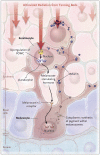Indoor tanning--science, behavior, and policy
- PMID: 20818900
- PMCID: PMC3951814
- DOI: 10.1056/NEJMp1005999
Indoor tanning--science, behavior, and policy
Figures

Similar articles
-
The Growing Public Health Challenges of Exposure to Ultraviolet Radiation From Use of Indoor Tanning Devices in the United States.New Solut. 2015 Aug;25(2):164-71. doi: 10.1177/1048291115586416. Epub 2015 May 20. New Solut. 2015. PMID: 25995373
-
[Why indoor tanning must be taxed? A proposal from La Sécurité Solaire, WHO collaborating centre].Presse Med. 2010 Dec;39(12):1236-7. doi: 10.1016/j.lpm.2010.09.006. Presse Med. 2010. PMID: 20970955 French. No abstract available.
-
Update on indoor tanning legislation in the United States.Clin Dermatol. 2015 May-Jun;33(3):387-92. doi: 10.1016/j.clindermatol.2014.12.016. Epub 2014 Dec 8. Clin Dermatol. 2015. PMID: 25889141
-
Teens and indoor tanning: a cancer prevention opportunity for pediatricians.Pediatrics. 2013 Apr;131(4):772-85. doi: 10.1542/peds.2012-2404. Epub 2013 Mar 18. Pediatrics. 2013. PMID: 23509165 Free PMC article. Review.
-
[Solaria, vitamin D, and skin cancer].Tidsskr Nor Laegeforen. 2010 Sep 23;130(18):1818-21. doi: 10.4045/tidsskr.09.0435. Tidsskr Nor Laegeforen. 2010. PMID: 20882079 Review. Norwegian.
Cited by
-
Identification of tyrosinase inhibitors from traditional Chinese medicines for the management of hyperpigmentation.Springerplus. 2015 Apr 17;4:184. doi: 10.1186/s40064-015-0956-0. eCollection 2015. Springerplus. 2015. PMID: 25932370 Free PMC article.
-
Relevance of Vitamin D in Melanoma Development, Progression and Therapy.Anticancer Res. 2020 Jan;40(1):473-489. doi: 10.21873/anticanres.13976. Anticancer Res. 2020. PMID: 31892603 Free PMC article. Review.
-
UV signaling pathways within the skin.J Invest Dermatol. 2014 Aug;134(8):2080-2085. doi: 10.1038/jid.2014.161. Epub 2014 Mar 12. J Invest Dermatol. 2014. PMID: 24759085 Free PMC article. Review.
-
Decrease in Self-Reported Tanning Frequency among Utah Teens following the Passage of Utah Senate Bill 41: An Analysis of the Effects of Youth-Access Restriction Laws on Tanning Behaviors.J Skin Cancer. 2014;2014:839601. doi: 10.1155/2014/839601. Epub 2014 Aug 20. J Skin Cancer. 2014. PMID: 25215240 Free PMC article.
-
Melanoma models for the next generation of therapies.Cancer Cell. 2021 May 10;39(5):610-631. doi: 10.1016/j.ccell.2021.01.011. Epub 2021 Feb 4. Cancer Cell. 2021. PMID: 33545064 Free PMC article. Review.
References
-
- Cui R, Widlund HR, Feige E, Lin JY, Wilensky DL, Igras VE, D’Orazio J, Fung CY, Schanbacher CF, Granter SR, Fisher DE. Central role of p53 in the suntan response and pathologic hyperpigmentation. Cell. 2007;128(5):853–864. - PubMed
MeSH terms
Substances
Grants and funding
LinkOut - more resources
Full Text Sources
Medical
